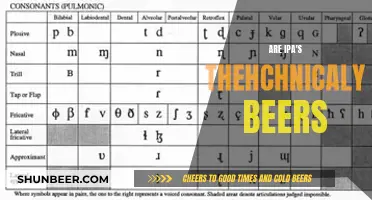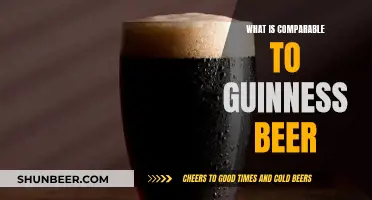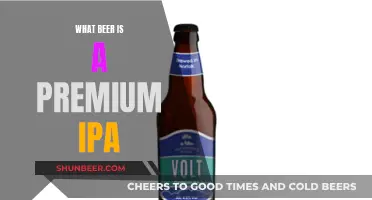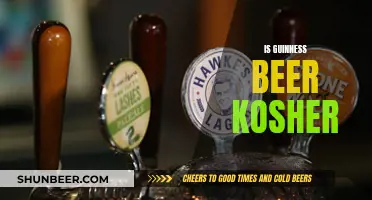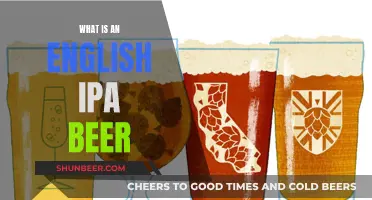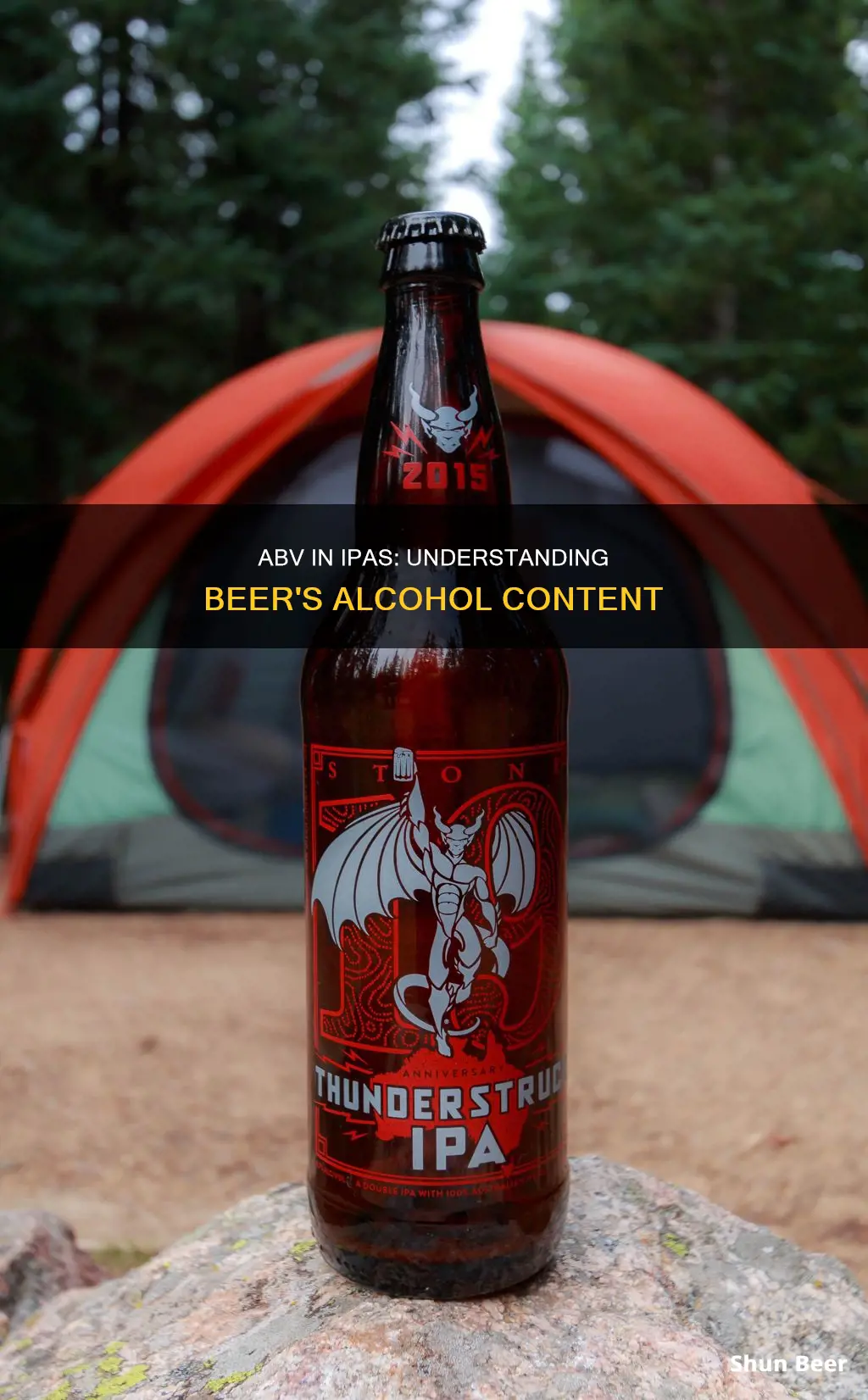
India Pale Ale (IPA) is a hoppy beer style within the broader category of pale ale. The ABV of an IPA varies, with some IPAs being stronger than the average regular beer, and some regular beers being stronger than the average IPA. IPAs are often in the 5-7% ABV range, but there are also alcohol-free IPAs and 13% ABV IPAs. For example, a Budweiser sits at 5% ABV, whereas an average IPA is 6%. A session IPA is a growing trend, with brewers acknowledging that not every beer should be super boozy, and these tend to be around 4.5-5% ABV. A double or imperial IPA is an IPA with a higher hop concentration, which results in a higher ABV (usually over 7%).
| Characteristics | Values |
|---|---|
| ABV range | 0% to 13% |
| Typical ABV range | 5% to 7% |
What You'll Learn

Session IPAs are usually below 5% ABV
India Pale Ale (IPA) is a hoppy beer style that originated in England in the 1700s and 1800s. The term "IPA" now encompasses a wide range of styles, including the Session IPA. Session IPAs are typically defined as those with an ABV of 5% or lower, although some purists argue that the style should be limited to beers with an ABV of 4% or even 3% or lower.
Session IPAs are designed to be lighter and more drinkable than traditional IPAs, without sacrificing flavour. They are often characterised by a strong hop character and a lower alcohol content, resulting in a thinner body and a less filling drinking experience. This style of beer originated in WWI-era England, when workers were allotted two drinking periods, or "sessions", of four hours each workday. The lower alcohol content of Session IPAs allowed workers to drink more beer without becoming inebriated.
While the ABV of a typical IPA can range from 6.5% to almost 8%, Session IPAs are designed to be more sessionable, meaning you can drink a few pints without feeling too full or intoxicated. The lower alcohol content of Session IPAs can, however, pose a challenge for brewers, as it can be difficult to achieve a balanced flavour profile with fewer malts and grains.
Some popular examples of Session IPAs include Founders Brewing's All Day IPA (4.7% ABV), Lagunitas Brewing's DayTime IPA (4.65% ABV), and Pizza Port's Ponto Session IPA (4.5% ABV). These beers showcase the unique characteristics of the style, combining a strong hop presence with a lower alcohol content to create a flavourful and drinkable beer.
Session IPAs offer a unique take on the traditional IPA style, providing a lighter and more sessionable option for beer enthusiasts. While they can be challenging to brew, Session IPAs have gained popularity for their ability to deliver the signature hop-forward flavour and aroma of IPAs in a more approachable package.
Guinness Beer: Understanding Its Unique Percentage Composition
You may want to see also

Double/Imperial IPAs have a higher ABV, typically over 7%
India Pale Ales (IPAs) are hoppier and more alcoholic than pale ales, but less alcoholic than Double IPAs. IPAs typically have an ABV of 6-7.5%.
Double IPAs, also known as Imperial IPAs, are a stronger, very hoppy variant of IPAs. They typically have an ABV of 7.5% and above. The term "double" refers to the increased amount of ingredients used, particularly hops, which results in a beer that is both higher in alcohol and richer in hop character compared to a standard IPA. The style is claimed to have originated with Vinnie Cilurzo, currently the owner of Russian River Brewing Company in Santa Rosa, California, in 1994 at the now-defunct Blind Pig Brewery in Temecula, California.
Double IPAs are essentially bolder versions of IPAs. They are stronger, hoppier, and more bitter. They have a strong hop profile with a wide range of flavours and aromas, ranging from citrusy and floral to earthy and resinous notes.
Double IPAs came about from a desire to create more intense brews. The higher alcohol content is a result of this push to create a more intense and hoppier beer.
The modern sub-styles of this beer are essentially the same as the sub-styles of IPAs. Each of the styles is basically a more intense and stronger version of a standard IPA. Popular sub-styles of this beer include the American Double IPA and the Juicy, Hazy New England-style IPA.
The Ultimate Guide to IPA Beer Perfection
You may want to see also

New England IPAs are unfiltered, hazy, and have low bitterness
The ABV (alcohol by volume) in an IPA beer can vary. A New England IPA, for example, typically has a high ABV of 6.3% to 7.5%.
The New England IPA is sometimes referred to as the "Anti-IPA" because it rejects the classic IPA's signature bitterness. Instead, it emphasises the juicy, fruity flavours and aromas of hops. This is achieved through late and dry hopping techniques, where hops are added later in the brewing process, creating a beer with a thicker, heavier body. The haze is likely a result of this heavy hopping, as well as the use of characterful yeast that doesn't settle out of the solution.
The unfiltered nature of New England IPAs is a departure from traditional brewing techniques, where brewers were taught to produce a clear, crisp beer. The hazy appearance, along with the low bitterness, makes this style of beer controversial in some brewing circles. However, it has gained a dedicated following, especially among those who don't typically enjoy the bitter taste of traditional IPAs.
The term "New England IPA" can be misleading, as many classic IPAs brewed in New England are not of this style. In fact, traditional IPAs have far more hop bitterness than New England IPAs, which may be more comparable to pale ales in terms of bitterness. Despite the controversy, the New England IPA has become a recognised style, with its own unique characteristics and a dedicated fan base.
Guinness Beer: Why Do Bubbles Go Down?
You may want to see also

Triple IPAs tend to have an ABV of 10% or higher
India Pale Ale (IPA) is a hoppy beer style within the broader category of pale ale. IPAs come in a range of styles, with varying alcohol by volume (ABV) percentages. The ABV of an IPA can depend on the number of hops used, with more hops generally leading to a higher ABV.
Double or Imperial IPAs, for example, are IPAs with a higher hop concentration. To balance the increased hop flavor, brewers use more malt, resulting in a higher ABV (usually over 7%).
Triple IPAs, as the name suggests, take this a step further. They are characterized by even higher hop flavors and alcohol content, with ABVs typically exceeding 10%. While the Brewers Association does not officially recognize the triple IPA as a beer style, ABV is generally used as the main determinant for this category.
Some examples of triple IPAs include Founders Brewing Company's Devil Dancer (12% ABV), Dogfish Head 120 Minute IPA (15-20% ABV), and Sierra Nevada's Hoptimum (9.6% ABV).
IPA Beers in Mexico: Exploring the Craft Scene
You may want to see also

Black IPAs are darker in colour but share the bitter, hoppy flavours of other IPAs
India Pale Ale (IPA) is a hoppy beer style within the broader category of pale ale. The colour of an IPA can vary from very pale golden to reddish amber. While IPAs are known for their bitterness, modern IPAs explore the world of fruity flavours that can be derived from hops.
Black IPAs, also known as Cascadian Dark Ale (CDA) or American Black Ale, are darker in colour but share the bitter, hoppy flavours of other IPAs. The use of roasted malts gives them a darker malty flavour. The style was created by Greg Noonan of Vermont Pub & Brewery in the early 1990s but did not become popular in the United States until 2009.
The name "Black IPA" has been the subject of much debate within the craft brewing world. While most American brewers use the term Black IPA, breweries in the Pacific Northwest refer to the style as Cascadian Dark Ale due to its use of Pacific Northwest hops. In 2010, the Brewers Association coined the term "American-Style India Black Ale" to settle the matter. However, this name was also criticised for being too general.
Black IPAs have a colour that ranges from dark brown to opaque black. They typically have a good head of light tan to mocha-coloured foam and a medium-light to medium body. The malt flavour profile of a Black IPA is usually clean and of low to medium strength, although some chocolate or coffee flavours are acceptable. The bitterness of a Black IPA should come mostly from the hops, with the bulk of the malt contributing only a small part.
The alcohol content of IPAs can vary widely. Session IPAs, which have a lower alcohol content, usually fall below 5% ABV. Double or Imperial IPAs, on the other hand, have a higher alcohol content, typically over 7%.
The Costly World of IPAs: Why So Expensive?
You may want to see also
Frequently asked questions
The ABV for IPAs can vary from 0% to 13%. Session IPAs are usually below 5% ABV, while Double IPAs tend to be above 7% ABV.
There is nothing inherently strong about an IPA compared to other beers. The perception that IPAs are stronger may be due to their increased popularity in the 2000s, which coincided with a growing appreciation for craft ales that tend to have higher ABVs than lagers and bitters commonly found in pubs.
Session IPAs are designed to have a lower ABV than typical IPAs, usually around 4.5-5% ABV. This allows drinkers to consume more of them in a drinking "session" without becoming overly intoxicated.


